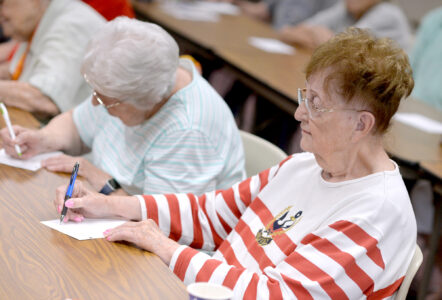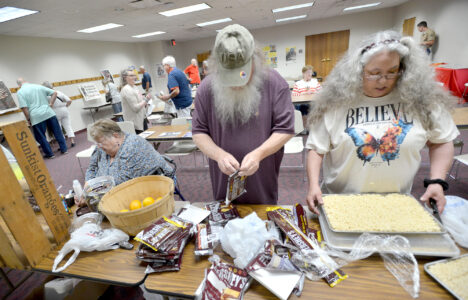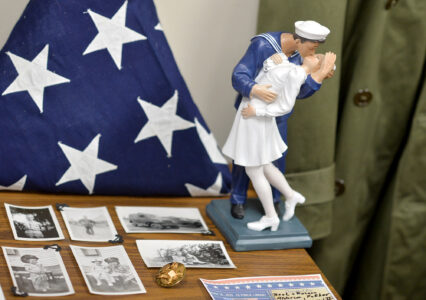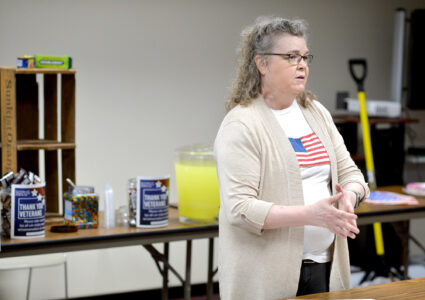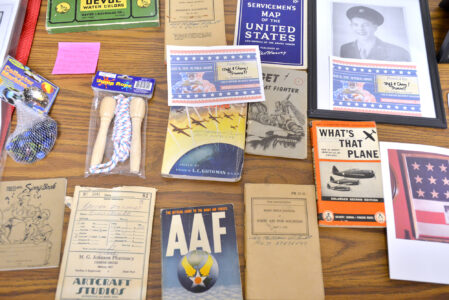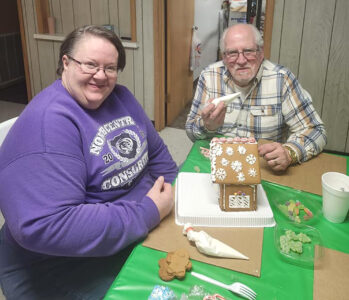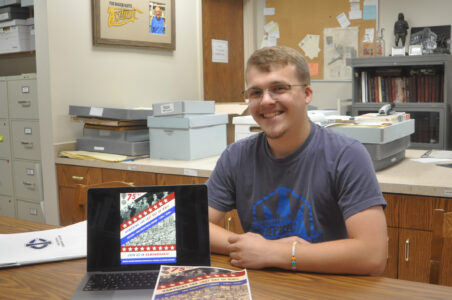‘We didn’t forget’
-
-Messenger photo by Hans Madsen
Jan Portz, of Fort Dodge, writes down some of her memories of World War II ending during a Webster County Historical Society celebration for the anniversary of the end of the war Saturday at the Fort Dodge Public Library. Sondra Thorson, center, of Fort Dodge, also jots down some memories. Their writings will be preserved by the Historical Society.
-
-Messenger photo
by Hans Madsen
Randy Hoover, of Fort Dodge, and his wife, Robin Hoover, prepare treats Saturday morning for the Webster County Historical Society celebration for the anniversary of the end of World War II. He sets up Hershey bars and she cuts up Rice Krispie treats. Both were popular treats at the time, with the chocolate bars often being a scarce commodity. Ruth Bennett, of Fort Dodge, is seated at left.
-
-Messenger photo by Hans Madsen
This statuette based on the famous Alfred Eisenstaedt photograph of a sailor kissing a nurse in Times Square graced the table along with donated photographs from the era Saturday at the Fort Dodge Public Library.
-
-Messenger photo by Hans Madsen
Meg Beshey, administrative assistant to Roger Natte of the Webster County Historical Society, talks about the end of the World War II era during a celebration of the anniversary of the war’s ending Saturday morning at the Fort Dodge Public Library.
-
-Messenger photo by Hans Madsen
A number of books, pamphlets and photographs donated by Jeff and Cheryl Trunnell, of Fort Dodge, were on display Saturday morning during the Webster County Historical Society celebration for the anniversary of the end of World War II at the Fort Dodge Public Library.
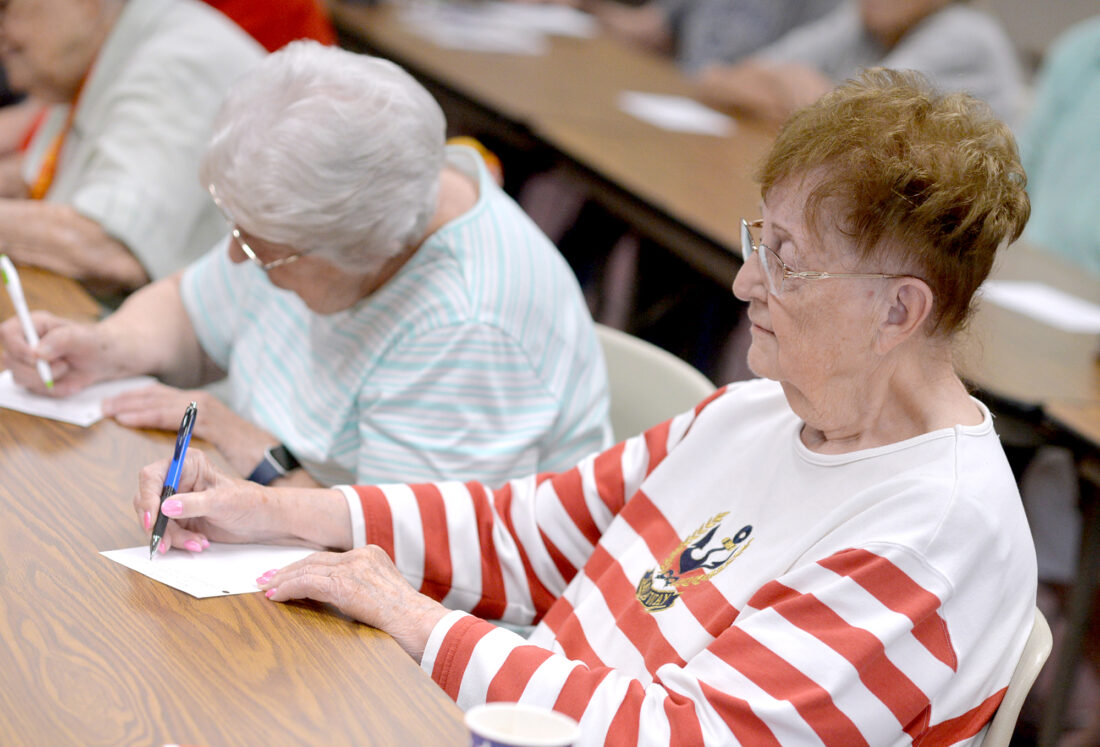
-Messenger photo by Hans Madsen
Jan Portz, of Fort Dodge, writes down some of her memories of World War II ending during a Webster County Historical Society celebration for the anniversary of the end of the war Saturday at the Fort Dodge Public Library. Sondra Thorson, center, of Fort Dodge, also jots down some memories. Their writings will be preserved by the Historical Society.
On Aug. 15, 1945, the United States’ ongoing war with Imperial Japan officially ended. The war in Europe had ended a few months before.
There was a mass celebration.
In New York’s Times Square, Alfred Eisenstaedt took his iconic image of a sailor kissing a nurse that would grace the cover of Life Magazine and, in many ways, sum up the day.
Closer to home, Sondra Thorsen, then 5 years old, got to witness a celebration in Kanawha where she grew up.
“There was a big parade and a street dance,” she said.
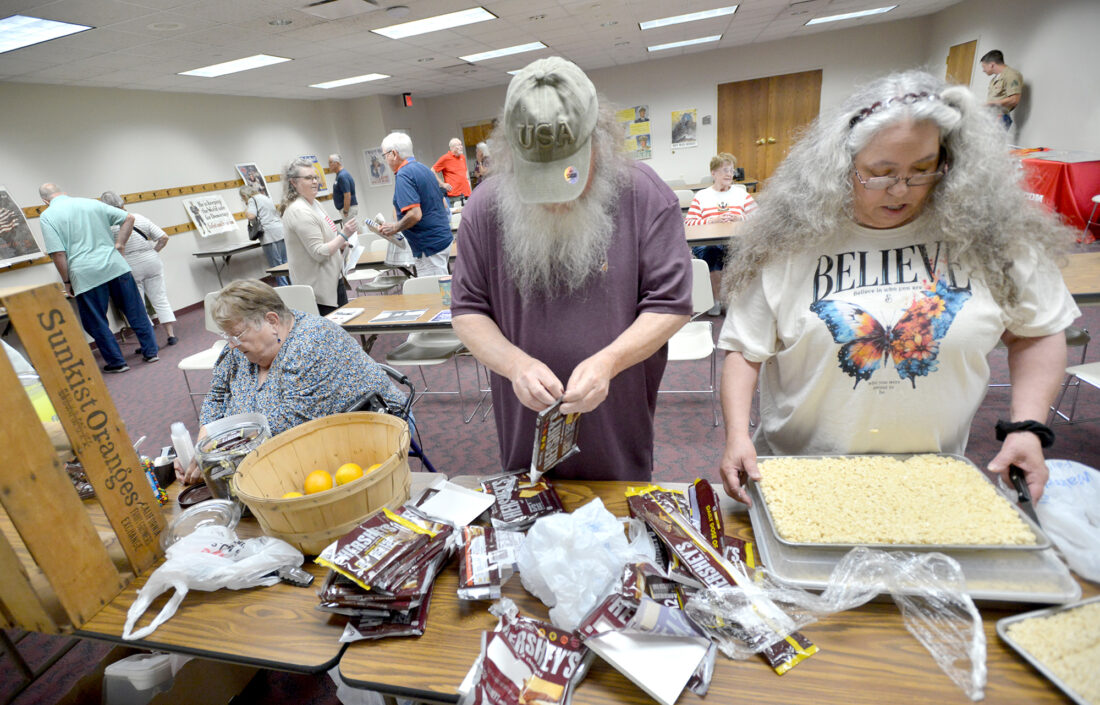
-Messenger photo
by Hans Madsen
Randy Hoover, of Fort Dodge, and his wife, Robin Hoover, prepare treats Saturday morning for the Webster County Historical Society celebration for the anniversary of the end of World War II. He sets up Hershey bars and she cuts up Rice Krispie treats. Both were popular treats at the time, with the chocolate bars often being a scarce commodity. Ruth Bennett, of Fort Dodge, is seated at left.
That was one of the things she wrote down for posterity during a Webster County Historical Society celebration for the anniversary of the end of World War II in the Fort Dodge Library.
“I remember when the war ended,” she added. “My dad was in the Navy and I knew he’d be coming home.”
There were many efforts on the home front to help the war effort. That included accepting shortages of some things and recycling.
“I remember ration books,” she said. “We saved foil, even foil from gum wrappers. We even saved the labels off of cans.”
Henrietta Van Maanen, who grew up in a nine-member family in Sioux County, remembered the rationing too.
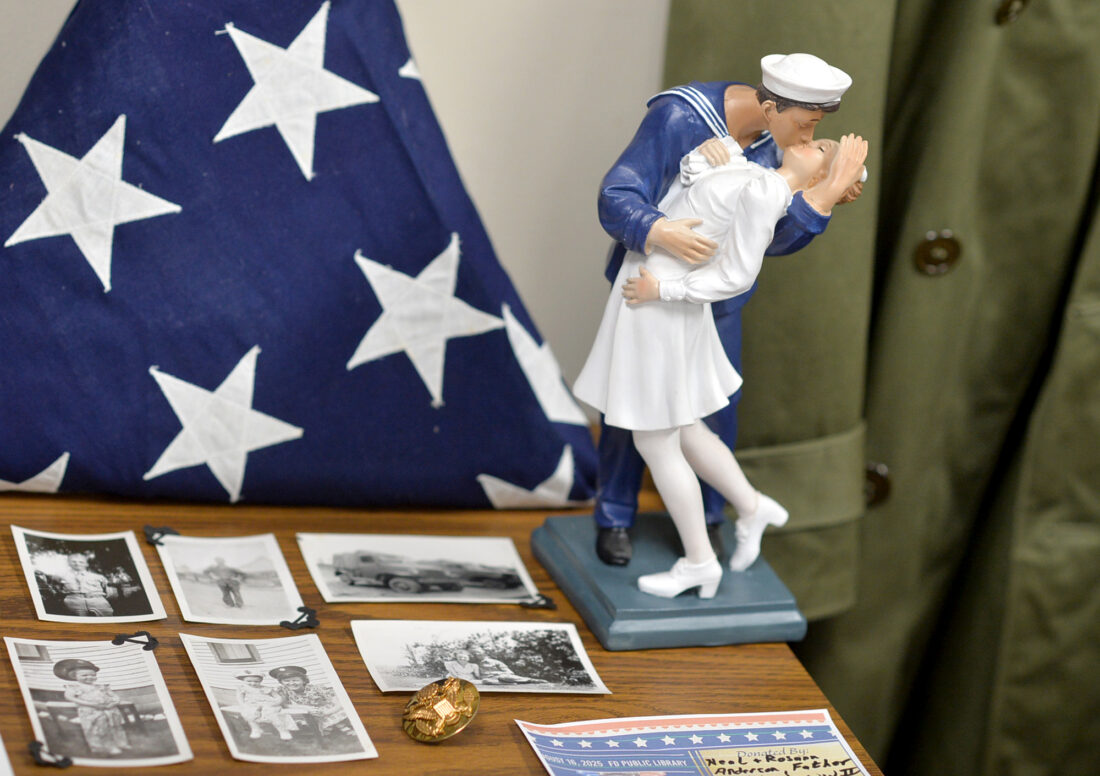
-Messenger photo by Hans Madsen
This statuette based on the famous Alfred Eisenstaedt photograph of a sailor kissing a nurse in Times Square graced the table along with donated photographs from the era Saturday at the Fort Dodge Public Library.
“We saved foil too. We patched tires, sugar was rationed, even butter sometimes,” Van Maanen said. “Gas was rationed too.”
They made do.
“We had a hired man that liked sugar. Since my siblings didn’t use that much, mother would use that for the men,” she said. “There just wasn’t much sugar.”
One way her mom made up for the lack of sugar was to substitute syrup for sugar in her cake recipe.
Did it match the flavor of the cake with sugar?
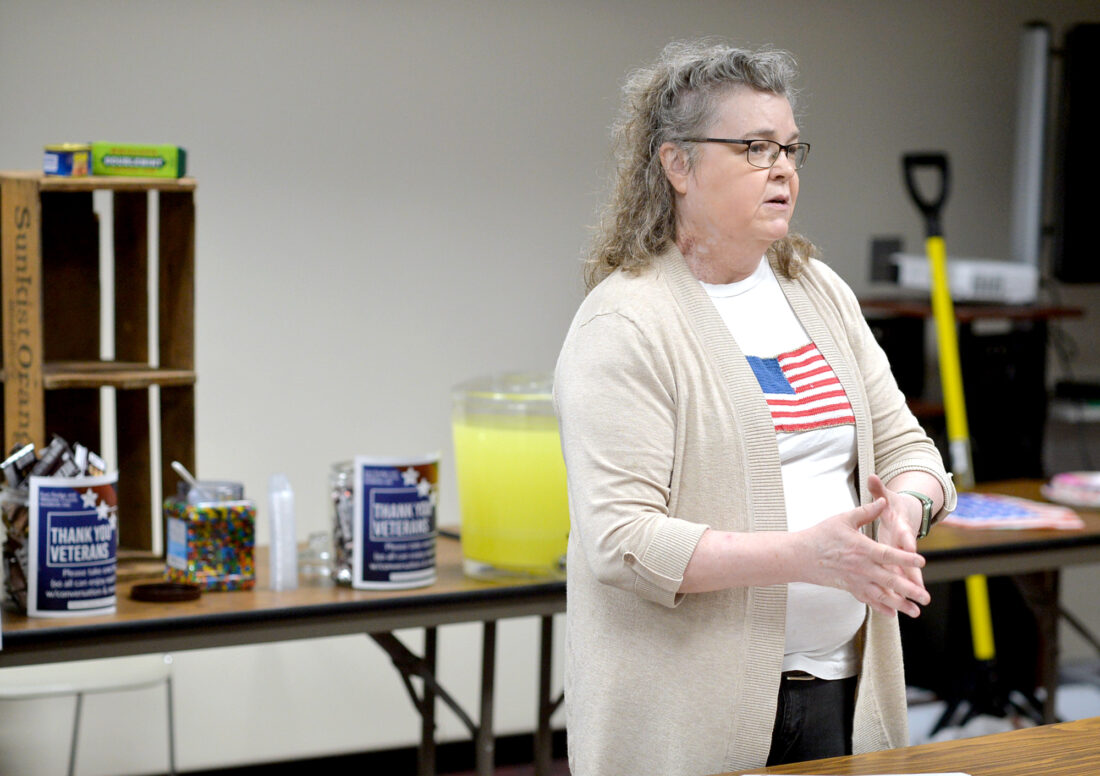
-Messenger photo by Hans Madsen
Meg Beshey, administrative assistant to Roger Natte of the Webster County Historical Society, talks about the end of the World War II era during a celebration of the anniversary of the war’s ending Saturday morning at the Fort Dodge Public Library.
“Who cared,” Van Maanen said. “It was cake.”
There was also a program for children, similar to the War Bonds program for adults, called Savings Stamps. The kids would buy stamps, stick them in an album, and later redeem them with interest.
“I would buy a dime or a nickel one,” she said. “I don’t remember ever having a quarter.”
Jan Portz, of Fort Dodge, was also 5 years old when the war ended.
“I remember sugar rationing,” Portz said. “If you got a candy bar, you had to split it with your siblings. That was a rare treat.”
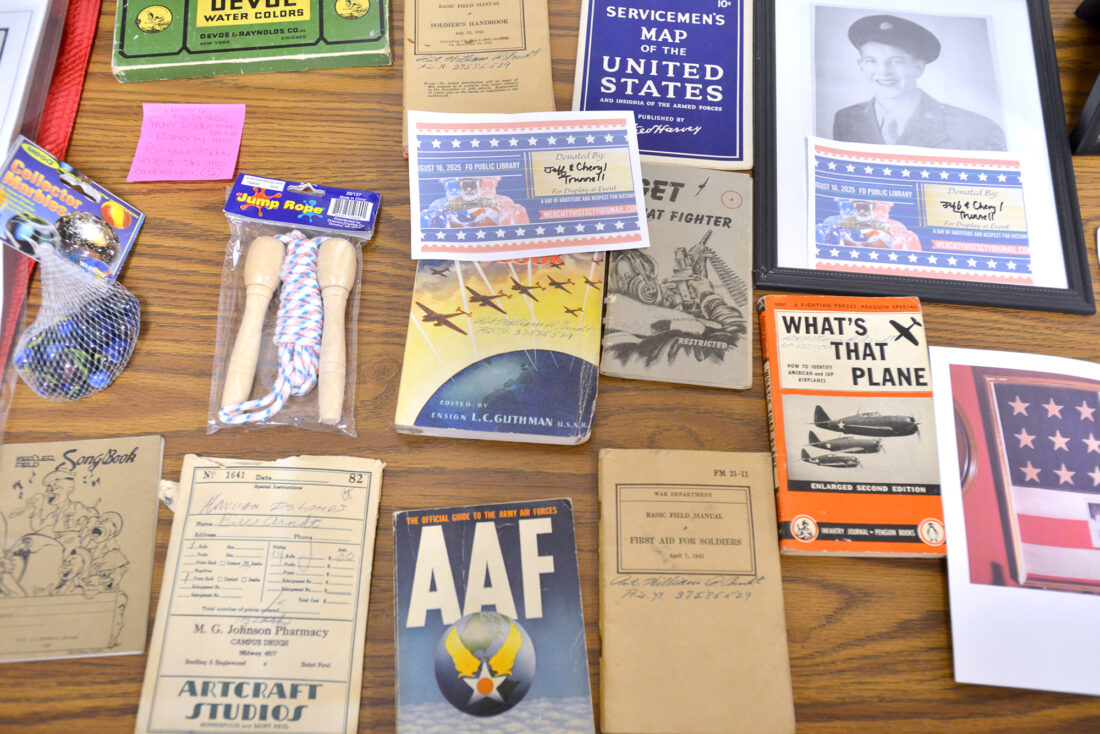
-Messenger photo by Hans Madsen
A number of books, pamphlets and photographs donated by Jeff and Cheryl Trunnell, of Fort Dodge, were on display Saturday morning during the Webster County Historical Society celebration for the anniversary of the end of World War II at the Fort Dodge Public Library.
Meg Beshey, who helped organize the event for the Historical Society, talked about the various things that people came up with to serve as substitutes for things that required sugar and other scarce food items.
“Rice Crispy bars became known as ‘war cake,'” she said.
Oranges were another scarce commodity.
“As the troop trains came through, soldiers would throw oranges at the kids along the way,” she said. “Treats were scarce.”
People of the time seemed to be very accepting of the sacrifices they were being asked to make on behalf of the war effort.
Portz isn’t sure that would be the case today.
“I don’t know if (this generation) could survive,” she said. “I don’t think a lot of them have wanted for anything.”
Jim Fevold, of Humboldt, also wrote down some memories.
“My mom made clothes out of feed sacks,” he said.
At the time, feed manufacturers and flower mills would have colorful patterns printed on their cotton sacks because they knew people would reuse them for making clothes.
He also joked about the current generation being just a little bit softer than his generation was and that it might benefit them to experience a bit of want.
“I think it would be good for them to go through that,” he said.

